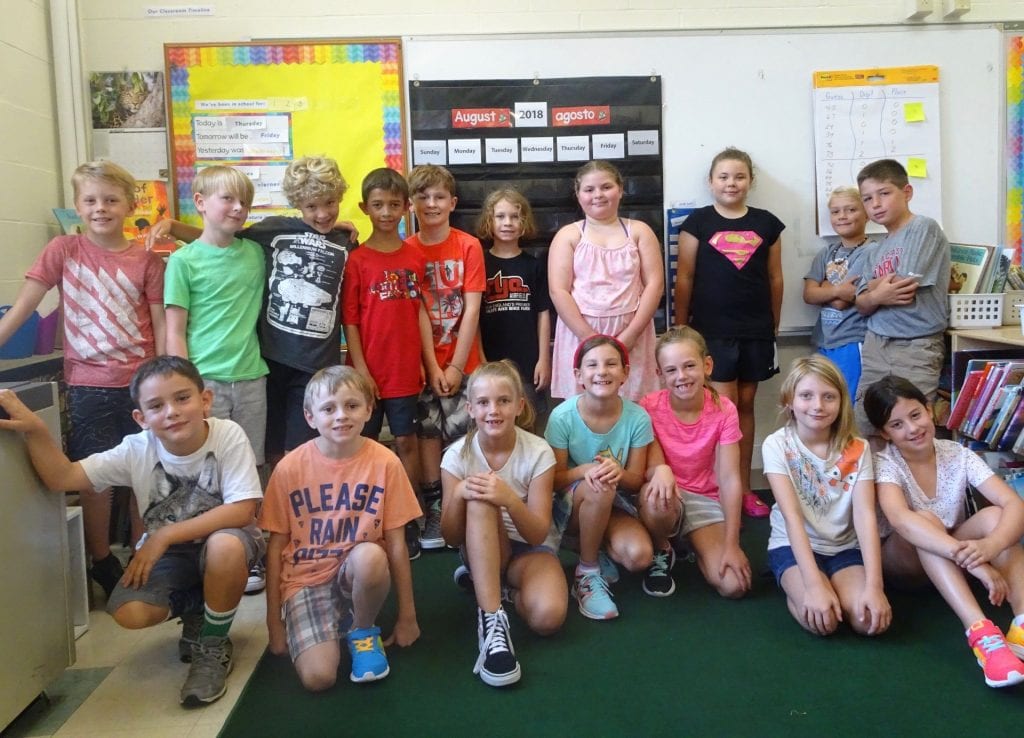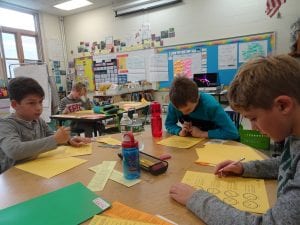 We’ve spent our week focused on portfolio preparations, beginning an inquiry into national holidays, learning more about elapsed time and stopping for a moment to count our blessings. We’ve learned a bit about the history of Thanksgiving and how it came to be celebrated. It’s kind of cool to know that New Hampshire’s own, Sarah Josepha Hale was instrumental in creating American’s special holiday. I am hopeful that by the time you read this note, each child will have completed his or her blog sharing a thankfulor gratefulacrostic. Their thoughts are beautiful. Enjoy them.
We’ve spent our week focused on portfolio preparations, beginning an inquiry into national holidays, learning more about elapsed time and stopping for a moment to count our blessings. We’ve learned a bit about the history of Thanksgiving and how it came to be celebrated. It’s kind of cool to know that New Hampshire’s own, Sarah Josepha Hale was instrumental in creating American’s special holiday. I am hopeful that by the time you read this note, each child will have completed his or her blog sharing a thankfulor gratefulacrostic. Their thoughts are beautiful. Enjoy them.
Student Goal Setting and Portfolio Shares
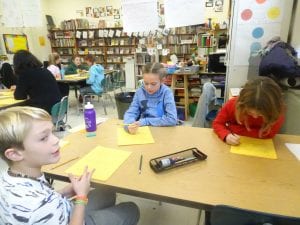 Thank you for spending time with your son or daughter as they shared what they are learning, their classroom and their goals for this year. They are growing their abilities to reflect on their learning processes. Since we began this process, they can already see they have changed. They realized how they grown as a mathematician by seeing problems from early October. It is motivating to find proof of learning and to feel the rewards of focus and effort. The more actively the children participate in their own learning, the more they will grow.
Thank you for spending time with your son or daughter as they shared what they are learning, their classroom and their goals for this year. They are growing their abilities to reflect on their learning processes. Since we began this process, they can already see they have changed. They realized how they grown as a mathematician by seeing problems from early October. It is motivating to find proof of learning and to feel the rewards of focus and effort. The more actively the children participate in their own learning, the more they will grow.
 It is exciting to see their thoughtfulness and their enthusiasm for sharing what they do each day. They deserve to be proud of their efforts and abilities to present their thinking and learning at this point in the year. I appreciate knowing what they are thinking. They always surprise me. Their ideas and approach to each task is totally unique. They teach me something new every day.
It is exciting to see their thoughtfulness and their enthusiasm for sharing what they do each day. They deserve to be proud of their efforts and abilities to present their thinking and learning at this point in the year. I appreciate knowing what they are thinking. They always surprise me. Their ideas and approach to each task is totally unique. They teach me something new every day.
Book Clubs – Keeping Track Thinking While Reading
 Last week the children participated in book clubs. Our first book club choices were centered on the idea that everyone can write what they know and feel in their hearts. All of these first choices were picture books and the clubs were designed so that everyone could meet the expectations of 1) completing the book, 2) writing a summary, 3) selecting a favorite part to speak to and 4) to make an inference about the author’s message. All of the children met these expectations and had some great discussions about their books and reading.
Last week the children participated in book clubs. Our first book club choices were centered on the idea that everyone can write what they know and feel in their hearts. All of these first choices were picture books and the clubs were designed so that everyone could meet the expectations of 1) completing the book, 2) writing a summary, 3) selecting a favorite part to speak to and 4) to make an inference about the author’s message. All of the children met these expectations and had some great discussions about their books and reading.
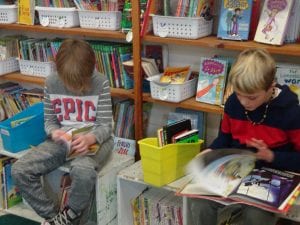 Our second book clubs selections all have something to do with Thanksgiving. They are nonfiction selections and have a wide range of length and complexity. We’ll be learning more about note-taking and questioning during these book club meetings. We’ll use what we learn during these meetings to guide us into our second inquiry project about national holidays.
Our second book clubs selections all have something to do with Thanksgiving. They are nonfiction selections and have a wide range of length and complexity. We’ll be learning more about note-taking and questioning during these book club meetings. We’ll use what we learn during these meetings to guide us into our second inquiry project about national holidays.
Bits and Pieces –
- We finished The Wild Roboton Wednesday. There was a resounding “YES” when I asked if we wanted to read The Wild Robot Escapes next. Roz is an amazing robot. We loved the book so much we’ve decided to build some robots of our own. It will be fun to see the personalities of our robots emerge.
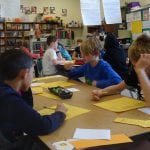
- Just a reminder – we’ve got a field trip on Monday to Strawbery Banke. We’ll be there for the morning and will be returning to school around 1:00. The children will need to bring their lunch – or order lunch from school as yesterday’s notice outlined. We’ll be eating lunch on the bus while we return from the program. Please be aware of the peanut and tree nut allergies in the grade. Thank you.
- We’ve continued to learn more about simple and compound sentences. We are learning more about the choices we make can add to interest to our writing.
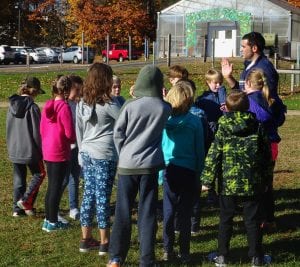 Happy Veterans Day! We’re getting ready to develop our weather forecasts as we end of our weather unit of study. This week we’ve begun exploring our nation’s history by learning some about our nine national holidays. We’ve continued to discuss and plan for how we can each contribute to the creation of a successful learning community. We’ve been learning about sentences and parts of speech – nouns, verbs and adjectives. And finally, we’ve been exploring time. We’re learning about elapsed time and how to use what we know about fives and multiplication to connect with telling time. We’re always trying to get the most out of our time.
Happy Veterans Day! We’re getting ready to develop our weather forecasts as we end of our weather unit of study. This week we’ve begun exploring our nation’s history by learning some about our nine national holidays. We’ve continued to discuss and plan for how we can each contribute to the creation of a successful learning community. We’ve been learning about sentences and parts of speech – nouns, verbs and adjectives. And finally, we’ve been exploring time. We’re learning about elapsed time and how to use what we know about fives and multiplication to connect with telling time. We’re always trying to get the most out of our time. We’ve been struggling with behavior for the past two weeks. Both of these weeks have been full of unusual schedules and events. Because of this, I waited to see if we could pull it together. Some have, but others have not. As a class, we mean well, but behavior choices have left much to be desired. This, along with little attention to personal best and/or thoughtful effort, is prompting me to ask you to have a chat with your child about what they might do to support their own learning. We’ve been reading about teamwork and cooperation. We’ve had lots of examples and now we need to make some important choices. If you have a chance, talk to your child about what s/he could do put forth best effort? Ask how can s/he contribute to creating a classroom community allowing everyone to succeed? These conversations will help us continue them in our classroom, so we can be sure that learning is what we are about at school.
We’ve been struggling with behavior for the past two weeks. Both of these weeks have been full of unusual schedules and events. Because of this, I waited to see if we could pull it together. Some have, but others have not. As a class, we mean well, but behavior choices have left much to be desired. This, along with little attention to personal best and/or thoughtful effort, is prompting me to ask you to have a chat with your child about what they might do to support their own learning. We’ve been reading about teamwork and cooperation. We’ve had lots of examples and now we need to make some important choices. If you have a chance, talk to your child about what s/he could do put forth best effort? Ask how can s/he contribute to creating a classroom community allowing everyone to succeed? These conversations will help us continue them in our classroom, so we can be sure that learning is what we are about at school.

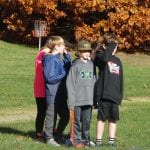
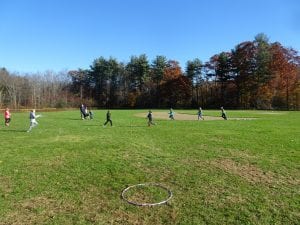 Our outdoor challenge this week was about teamwork too. The class was divided into groups and sent to three different stations. We were told we had to listen carefully to all the directions, take turns and allow everyone to participate. Our goal was to move all the objects from one hoop into another hoop. With those directions, the class began. Ask your child what he or she discovered working through this challenge. Perhaps Open Circle and the challenge can help your child in coming up with ideas of how our classroom can be a place where everyone can succeed in the manner that makes him or her proud.
Our outdoor challenge this week was about teamwork too. The class was divided into groups and sent to three different stations. We were told we had to listen carefully to all the directions, take turns and allow everyone to participate. Our goal was to move all the objects from one hoop into another hoop. With those directions, the class began. Ask your child what he or she discovered working through this challenge. Perhaps Open Circle and the challenge can help your child in coming up with ideas of how our classroom can be a place where everyone can succeed in the manner that makes him or her proud.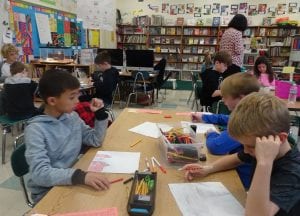 We’ve been exploring different types of sentences. We’ve learned about simple, and compound sentences. We know each sentence has a noun that is its subject. We know that the subject of the sentence has to do something, and then we are hoping to elaborate on the basic sentence structure by adding adjectives to paint a picture of our meaning with our word choice.
We’ve been exploring different types of sentences. We’ve learned about simple, and compound sentences. We know each sentence has a noun that is its subject. We know that the subject of the sentence has to do something, and then we are hoping to elaborate on the basic sentence structure by adding adjectives to paint a picture of our meaning with our word choice. We’re nearing the end of
We’re nearing the end of 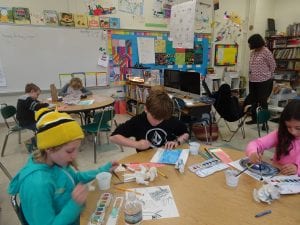

 Student-Led Goal setting conferences will be on Thursday, November 15 or Friday, November 16.
Student-Led Goal setting conferences will be on Thursday, November 15 or Friday, November 16.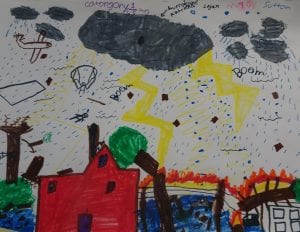 Most of the children were able to create a blog post to share the informational writing they created to share all they had learned about the weather topic they chose to research and study.
Most of the children were able to create a blog post to share the informational writing they created to share all they had learned about the weather topic they chose to research and study.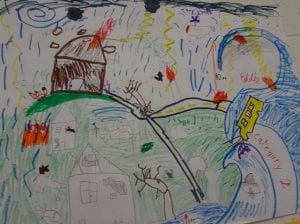 When you read through their posts you can learn about sandstorms and blizzards, hurricanes and tornadoes. You can learn about snow, clouds rainbows and meteorology too. They have worked for several weeks to do the research, type their information and publish both illustrated books and these blog posts that are accompanied by another piece of original art.
When you read through their posts you can learn about sandstorms and blizzards, hurricanes and tornadoes. You can learn about snow, clouds rainbows and meteorology too. They have worked for several weeks to do the research, type their information and publish both illustrated books and these blog posts that are accompanied by another piece of original art.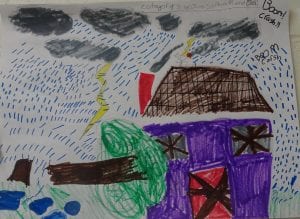
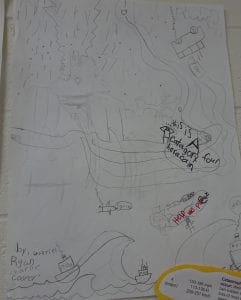 This post is illustrated by cooperative, small-group illustrations made to show the five hurricane levels defined by the Saffir-Simpson Wind Scale.
This post is illustrated by cooperative, small-group illustrations made to show the five hurricane levels defined by the Saffir-Simpson Wind Scale.
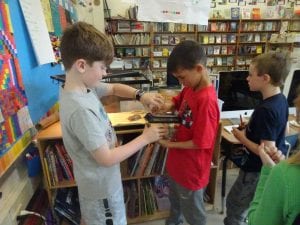 What an exciting week – Trick-or-Treating, Halloween and welcoming our new classroom pet. Finally the Reptile Keeper has a real job to do everyday. On top of all that, our week has also been filled with reading, writing, researching, science and problem solving. Your children are hardworking, flexible and interested in learning. It seems as though 3E is a good place to be learning.
What an exciting week – Trick-or-Treating, Halloween and welcoming our new classroom pet. Finally the Reptile Keeper has a real job to do everyday. On top of all that, our week has also been filled with reading, writing, researching, science and problem solving. Your children are hardworking, flexible and interested in learning. It seems as though 3E is a good place to be learning. This week we continued our goal setting process. As I’ve already shared, the students have described themselves as learners using the Multiple Intelligences model, they’ve described themselves as readers and writers, chosen “best” books and pieces of writing to highlight what they are capable of doing independently at this point in the school-year and set reading and writing goals. These goals come from the traits of successful readers and writers we generated as a class. Each of the children has chosen something they feel they would like to pay attention to and improve. Our last goal-setting area is math. We will have they completed by the middle of next week. We’ll spend a few days organizing our portfolios and planning how we will share all our ideas with our families. In the second week of November we will be organized and ready to share.
This week we continued our goal setting process. As I’ve already shared, the students have described themselves as learners using the Multiple Intelligences model, they’ve described themselves as readers and writers, chosen “best” books and pieces of writing to highlight what they are capable of doing independently at this point in the school-year and set reading and writing goals. These goals come from the traits of successful readers and writers we generated as a class. Each of the children has chosen something they feel they would like to pay attention to and improve. Our last goal-setting area is math. We will have they completed by the middle of next week. We’ll spend a few days organizing our portfolios and planning how we will share all our ideas with our families. In the second week of November we will be organized and ready to share.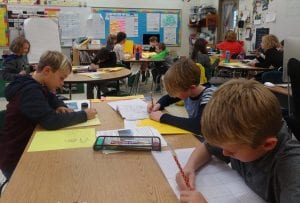 The students will lead their conference and share their learning profiles, work samples and goals with you. The main goal of this reflection and writing SEL project is to help the children come to understand themselves as learners a bit better. It is designed to help each of them realize they are unique and totally capable of accomplishing whatever they are willing to work for.
The students will lead their conference and share their learning profiles, work samples and goals with you. The main goal of this reflection and writing SEL project is to help the children come to understand themselves as learners a bit better. It is designed to help each of them realize they are unique and totally capable of accomplishing whatever they are willing to work for.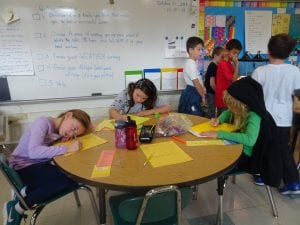 We’ve continued to learn more about adjectives and descriptive writing. We’ve practiced writing descriptive sentences about weather. We’ve had the chance to create adjective poems. We made one together about our gecko and the children wrote their own about the leaves they created in our symmetry project.
We’ve continued to learn more about adjectives and descriptive writing. We’ve practiced writing descriptive sentences about weather. We’ve had the chance to create adjective poems. We made one together about our gecko and the children wrote their own about the leaves they created in our symmetry project. : to write what they understand, to write to teach others, to write in their own words, to write between 25 and 30 sentences (at least five sentences about five sub-topics) – more is always better, and to create their own illustrations to share their understanding of the topic. They are excited to be sharing their weather library with others.
: to write what they understand, to write to teach others, to write in their own words, to write between 25 and 30 sentences (at least five sentences about five sub-topics) – more is always better, and to create their own illustrations to share their understanding of the topic. They are excited to be sharing their weather library with others.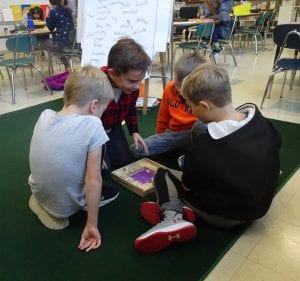 We’ve continued to explore
We’ve continued to explore 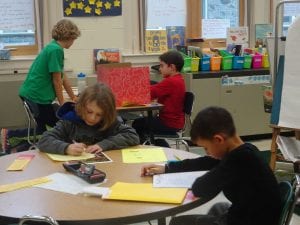 Our
Our 

 We are very busy. We’re trying to establish a safe habit for our class reptile – leopard geckos. They live in the desert so it has to be hot. We are trying to find a safe way to make sure the temperature doesn’t drop too much at night and on the weekends. It’s been an interesting and exciting process. We also had the opportunity (a high pressure system moving in) to set up our storm glass so now our weather corner has another tool that we can use to predict the weather.
We are very busy. We’re trying to establish a safe habit for our class reptile – leopard geckos. They live in the desert so it has to be hot. We are trying to find a safe way to make sure the temperature doesn’t drop too much at night and on the weekends. It’s been an interesting and exciting process. We also had the opportunity (a high pressure system moving in) to set up our storm glass so now our weather corner has another tool that we can use to predict the weather.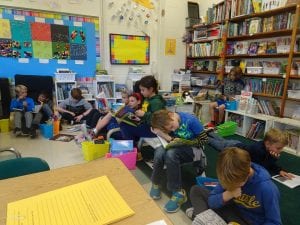 This week we’ve spent time thinking about goals. We’ve tried to be specific. We’ve tried to make our goals about something important and doable. We’re also thinking about the evidence we might collect to show we have accomplished our goals.
This week we’ve spent time thinking about goals. We’ve tried to be specific. We’ve tried to make our goals about something important and doable. We’re also thinking about the evidence we might collect to show we have accomplished our goals. Once we discovered what we might do to grow as readers, we set a goal for the week. We called it a W.O.W. (within one week) goal. We’ve discovered that even though we know how we might improve our reading skills, we don’t always do what will help us. We really do have to make a plan if we are going to accomplish what we set out to do. We’re trying to explore new books and spend more time thinking about what we’re reading. They deserve to be proud of all they are attempting and doing as readers.
Once we discovered what we might do to grow as readers, we set a goal for the week. We called it a W.O.W. (within one week) goal. We’ve discovered that even though we know how we might improve our reading skills, we don’t always do what will help us. We really do have to make a plan if we are going to accomplish what we set out to do. We’re trying to explore new books and spend more time thinking about what we’re reading. They deserve to be proud of all they are attempting and doing as readers.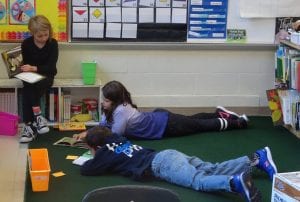 This month our calendar is filled with a pattern of polygons. We’re learning about different types of triangles, quadrilaterals, pentagons and hexagons. We’ve discovered that when they are called “regular” shapes the sides and angles are equal. “Regular” shapes often have many lines of symmetry. Symmetry is all around us. We’ve looked for things in the classroom that are symmetrical and we’ve explored symmetry in nature too.
This month our calendar is filled with a pattern of polygons. We’re learning about different types of triangles, quadrilaterals, pentagons and hexagons. We’ve discovered that when they are called “regular” shapes the sides and angles are equal. “Regular” shapes often have many lines of symmetry. Symmetry is all around us. We’ve looked for things in the classroom that are symmetrical and we’ve explored symmetry in nature too.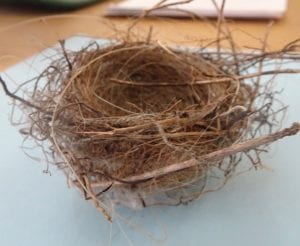 Survival
Survival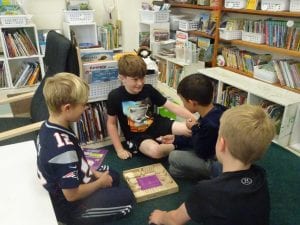 The Wild Robot
The Wild Robot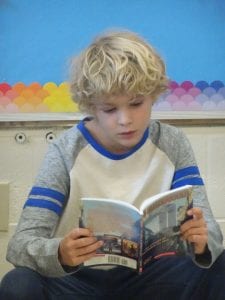 3rd Grade Challenges – 3E
3rd Grade Challenges – 3E We are having lots of fun blogging. Thank you so much for the wonderful comments. Having an audience for our writing and our ideas is very motivating.
We are having lots of fun blogging. Thank you so much for the wonderful comments. Having an audience for our writing and our ideas is very motivating.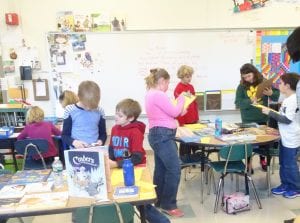 Thanks for supporting our reading museum and helping the children take note of he fact that learning continues on and on. Thank you also for your attention to making time for homework. Many of the kids were super excited about having that responsibility. We began our week by thinking about a series of precepts: “If at first you don’t succeed, try, try again.”, “Practice makes perfect.”, “”Whether you think you can or whether you think you can’t, you’re probably right.”, and ”Practice makes progress.” We had some great conversation about what we can do to make sure learning grows.
Thanks for supporting our reading museum and helping the children take note of he fact that learning continues on and on. Thank you also for your attention to making time for homework. Many of the kids were super excited about having that responsibility. We began our week by thinking about a series of precepts: “If at first you don’t succeed, try, try again.”, “Practice makes perfect.”, “”Whether you think you can or whether you think you can’t, you’re probably right.”, and ”Practice makes progress.” We had some great conversation about what we can do to make sure learning grows.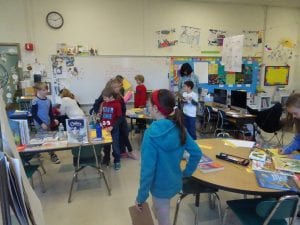
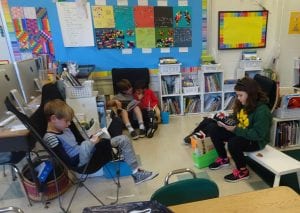 After the museum on Tuesday, we reflected on the reading we’d been doing in the first month and a half of school. We thought about the books we’d been choosing to read and we considered the difference between “reading”, “skimming and scanning” and “looking through.” All are important habits to have, but we agreed that much of the time we have in our classroom with books should be dedicated to reading. The only way to grow as a reader is to practice. We reflected on what we’d been reading so far and the school year, and what habits we’d been most focused on. Are next steps will be to develop goals that will lead us forward and help us to grow.
After the museum on Tuesday, we reflected on the reading we’d been doing in the first month and a half of school. We thought about the books we’d been choosing to read and we considered the difference between “reading”, “skimming and scanning” and “looking through.” All are important habits to have, but we agreed that much of the time we have in our classroom with books should be dedicated to reading. The only way to grow as a reader is to practice. We reflected on what we’d been reading so far and the school year, and what habits we’d been most focused on. Are next steps will be to develop goals that will lead us forward and help us to grow. We’ve been learning how to use what we know about place value to help us multiply larger amounts. We’ve been trying to use the distributive property, because these steps more often help us with accuracy. They remind use to multiply everything – not just the hundreds and tens, but also the ones.
We’ve been learning how to use what we know about place value to help us multiply larger amounts. We’ve been trying to use the distributive property, because these steps more often help us with accuracy. They remind use to multiply everything – not just the hundreds and tens, but also the ones. We learned about four different types of leads: snapshot, question, dialogue and onomatopoeia. We had a go at playing around with each of them. We’ve tried choosing words that paint a picture. We’ve thought about the sounds we’d hear if we were to enter the setting of our piece of writing to consider if that would make an impactful start. We’ve thought of creating characters to speak and introduce our topic or story. And finally, we’ve wonder about the questions we hope our writing will answer. See if your child can tell you about the lead he or she is most interested in using to introduce readers to weather.
We learned about four different types of leads: snapshot, question, dialogue and onomatopoeia. We had a go at playing around with each of them. We’ve tried choosing words that paint a picture. We’ve thought about the sounds we’d hear if we were to enter the setting of our piece of writing to consider if that would make an impactful start. We’ve thought of creating characters to speak and introduce our topic or story. And finally, we’ve wonder about the questions we hope our writing will answer. See if your child can tell you about the lead he or she is most interested in using to introduce readers to weather. We’ve posted
We’ve posted 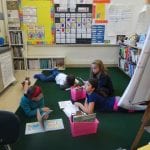

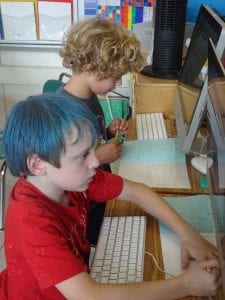
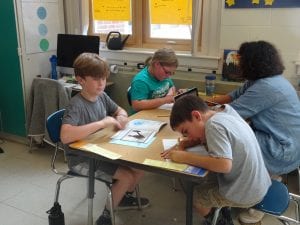
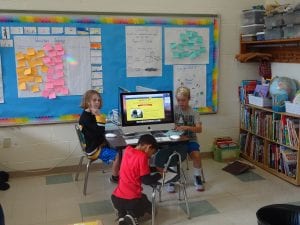 For a short week, we certainly fit a lot in. We continued our weather research. We’re finding out a lot of interesting facts. We began student blogging this week. The class is very excited about creating a first post. Thanks to those families who were able to read them and leave a comment. Please share the blog url with family and friends, near and far. It is exciting to open the blogs and find comments from grandparents, aunts and uncles. Thank you for your time and attention with this.
For a short week, we certainly fit a lot in. We continued our weather research. We’re finding out a lot of interesting facts. We began student blogging this week. The class is very excited about creating a first post. Thanks to those families who were able to read them and leave a comment. Please share the blog url with family and friends, near and far. It is exciting to open the blogs and find comments from grandparents, aunts and uncles. Thank you for your time and attention with this.

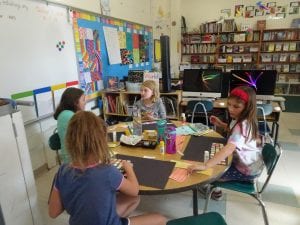 We’ve been learning how to create and read arrays. This practice enabled all of us to understand how the Commutative Property of Multiplication works. It doesn’t matter if you have 3 rows of 4 or 4 rows of 3. Both equal twelve. To show this understanding we made buildings to create Multiplication Main Street. Our buildings show how this property works.
We’ve been learning how to create and read arrays. This practice enabled all of us to understand how the Commutative Property of Multiplication works. It doesn’t matter if you have 3 rows of 4 or 4 rows of 3. Both equal twelve. To show this understanding we made buildings to create Multiplication Main Street. Our buildings show how this property works.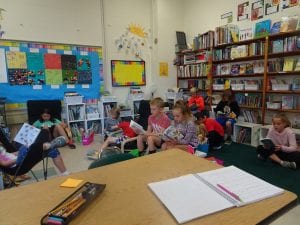
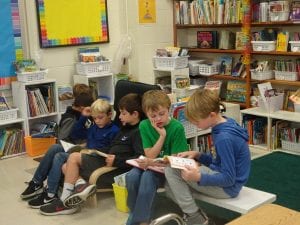
 We’ve begun our
We’ve begun our 
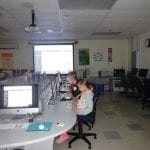 We have continued to work on our
We have continued to work on our 